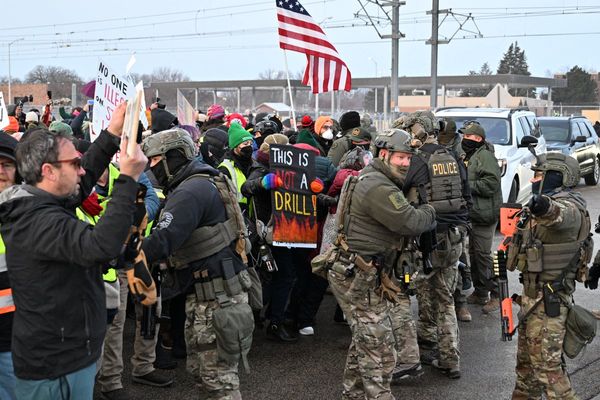The last remnants of the Ukrainian forces defending the south-eastern port city of Mariupol are reportedly holding out in underground shelters beneath the vast Azovstal steel plant, along with about 1,000 civilians.
"Mostly the [civilians] are women with children and old people," the city council wrote on the Telegram messaging app on Monday local time.
Mariupol has been under siege since March 2 and Russian forces have managed to take almost complete control.
The city would be a huge strategic prize, linking territory held by pro-Russian separatists in the east with the Crimea region that Moscow annexed in 2014.
However, the remaining Ukrainian forces have so far remained difficult to root out from the steelworks, which have been likened to a "fortress".
What was the steelworks like before the invasion?
The Azovstal iron and steel works — which was established by the USSR in the 1930s and rebuilt after the Nazi occupation during World War II — is one of Europe's biggest metallurgical plants.
Like the city's Illich Steel and Iron Works, Azovstal is held by Metinvest, a group controlled by billionaire Rinat Akhmetov, Ukraine's richest man.
In peacetime it pumped out 4 million tonnes of crude steel a year, 3.5 million tonnes of hot metal and 1.2 million tonnes of finished rolled steel.
In the east of the city devastated by weeks of shelling, the plant lies in an industrial area that looks out to the Sea of Azov and covers more than 11 square kilometres, containing myriad buildings, blast furnaces and rail tracks — all connected by a vast network of subterranean tunnels.
Why have Ukrainian forces taken refuge in a steelworks?
Yan Gagin, an advisor to the Russian-backed separatist forces in Donetsk, told Russian television the siege of Mariupol was taking so long because the Azovstal plant was like a city under a city.
He said the tunnels could withstand bombings and "even a nuclear strike".
Oleh Zhdanov, a military analyst based in Kyiv, said: "The Azovstal factory is an enormous space with so many buildings that the Russians … simply can't find [the Ukrainian forces]."
"That's why [the Russians] started talking about trying a chemical attack, that's the only way to smoke them out."
Ukraine has said it is checking unverified information that Russia may have already used chemical weapons in Mariupol. Russia-backed separatists have denied using them.
"These are huge territories with workshops that can't be destroyed from the air, which is why the Russians are using heavy bombs," said Sergiy Zgurets, a military analyst.
What Ukrainian forces remain holed up in the steelworks?
The lack of mobile reception and internet in Mariupol means information is scant, and Ukraine has kept tight control of details like troop numbers that could compromise its defence.
Mayor Vadym Boychenko said last week several Ukrainian units were still fighting in the city, including the 36th Marine Brigade, Interior Ministry troops, border guards and the Azov Regiment, originally a militia created by far-right nationalists, which was later incorporated into Ukraine's National Guard.
The Azov Regiment's destruction is among Moscow's war objectives, and the unit is prominently associated with Azovstal. One of its founders Andriy Biletskiy has called the industrial complex "the fortress of the Azov".
Mr Biletskiy told Ukraine's NV news site on March 20 that Ukraine had a total of 3,000 fighters defending the city against up to 14,000 Russians.
According to Ukraine, there are also some members of the 36th Marine Brigade bunkering down with the Azov soldiers.
The marines were maintaining defensive positions at Mariupol's Azovmash and Zavod Ilyicha factories until they ran out of supplies and ammunition and made a desperate attempt to break through the Russian blockade last week.
In a post on the brigade's Facebook page, one of its officers described how "for more than a month, the marines have been fighting without replenishing ammunition, food and water supplies".
"The wounded accounted for nearly a half of the brigade's strength, but those who still had their limbs and were capable of walking reported back to duty," it said.
The Russian military said last week that 1,160 marines had surrendered, a claim that could not be independently verified.
Mr Boychenko said some were captured by the Russians but others managed to join the Azov Regiment. He didn't give any numbers.
How long can the Ukrainian forces hold out there?
Russia issued an ultimatum for Ukrainian forces in Mariupol to lay down their arms from 6am Moscow time on Sunday to save their lives.
However, the ultimatum was ignored.
Denis Prokopenko, a lieutenant colonel of the Azov Regiment, said in a Telegram video post that while he was at the steel plant, Russian and separatist forces were dropping anti-bunker bombs and blasting the area with rockets and other weapons, including from ships, "knowing that there are civilians here".
Ukraine on Monday called for Russia to open a humanitarian corridor for evacuees from the city and steel plant.
"We demand an urgent humanitarian corridor from the territory of the Azovstal plant for women, children and other civilians," Deputy Prime Minister Iryna Vereshchuk said.
An EU security source told Reuters it was to difficult to say how long the Ukrainians could hold on and also difficult for Russia to occupy the whole city because of the industrial complexes.
"Mariupol is very important to Putin because after a victory there [and the surrender of the Azov troops] he can claim that the 'denazification' process is successful," the source added.
Mr Zhdanov, the military analyst, said he saw little chance of Ukrainian forces from the outside breaking through Russia's siege.
"How many supplies the defenders have and how long they can hold on is anyone's guess," he said.
"But they have no other way out. They're surrounded on all sides, they have to stand till the end. If they give in, they will not be spared."
ABC/Reuters







